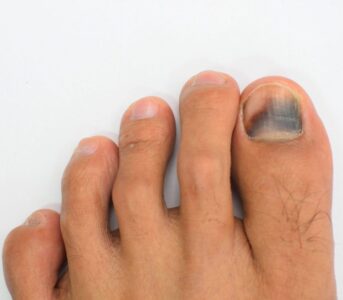 A healthy toenail is typically described as clear or translucent in color, but from time to time you may notice that one or more of your toenails has taken on a different hue. Is this something to be concerned with, or will it eventually clear up on its own? In today’s blog, we take a closer look at some of the common causes of discolored toenails and how you should treat some of these potential issues.
A healthy toenail is typically described as clear or translucent in color, but from time to time you may notice that one or more of your toenails has taken on a different hue. Is this something to be concerned with, or will it eventually clear up on its own? In today’s blog, we take a closer look at some of the common causes of discolored toenails and how you should treat some of these potential issues.
Why Are My Toenails Discolored?
Your toenails could take on a number of different shades as a result of trauma or an underlying condition, so instead of going through each color, we’re going to break the discoloration into two more common groups – lighter and darker. But before we dive into this, we just want to remind you that you should always seek out an in-person consultation if you have any concerns about toenail discoloration, and that the following is just general advice.
Light Colors
It’s not uncommon for your toenails to take on a whiter or yellowish appearance, and oftentimes this is the result of a toenail fungus. In many instances, toenail fungus can be treated with over-the-counter topical products, but for more advanced stages, connecting with a foot specialist may be your best move. There’s also the possibility that this discoloration is tied to a smoking habit, and quitting smoking would lead to a normalization of toenail color.
If you’re dealing with some pink or redness just to the side of the nail, you may be noticing the beginning stages of an ingrown toenail as it begins to irritate the nearby skin. You can learn more about how you can treat chronic ingrown toenails on this page.
Finally, if your toenail develops some small white streaks, it could be the result of a condition known as leukonychia. There are a number of different underlying causes that could lead to leukonychia, and it could suggest that there is an issue with a key protein inside your body that should be identified. Reach out to a specialist if you notice white streaking or a complete whitening of one or more toenails.
Dark Colors
The most common cause of dark discoloration underneath a toenail is the result of a subungual hematoma, and while it may sound serious, that’s the medical term for a bruise. If you have suffered trauma to the nail bed, or you simply wore ill-fitting shoes for an extended period of time, don’t be surprised if you have some brown, purple or black discoloration under your nail bed as a result of a subungual hematoma. Protect the area and limit time in tight-fitting shoes, and the issue will likely resolve on its own after a few days or weeks.
Dark yellow, dark green or brownish nails could be a sign of a more severe toenail infection. Typically it would only progress to this stage if a lighter color toenail discoloration went ignored. Severe toenail infections may also present with nail cracking and are best treated by a foot specialist.
Finally, red or black toenails, or toenails with dark colored spots should be reported to your primary care physician or a foot specialist. Those could be indicative of certain types of cancer that should be examined sooner rather than later.